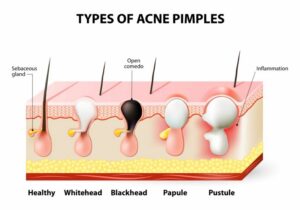WHAT ARE BLACK HEADS?
If you are a teenager and reading this, you will be well familiar with black heads. Specially around your nose, chin and forehead. This is what’s known as the T-zone of the face where it there are more sebum glands and hence more oil production.
Understanding the structure of the skin will help to understand the reason for black heads. The skin is your biggest living organ and your only protecting barrier against the external environment. It is porous, meaning it absorbs what you put on your skin to a greater extent.
Pores are small openings in the skin that release oils and sweat. They’re also connected to your hair follicles. These pores are allowing hair to grow through, sweat and oils to be released to the surface of the skin.
These pores can vary in size and actually do increase and decrease with certain stimuli. The most effective stimuli are the hormonal changes during puberty and menopause. However, the greatest determining pore size factor is genetics. Dry skin appears to have smaller pores whilst greasy skin has pores that appear to be larger and more visible. Aging and loss of elasticity in the skin also increases pore size.
Sebum is the oily waxy secretion from your skin glands helping to coat, moisturize, and protect your skin against the elements. Infact it water proofs your skin.
During puberty the oil glands under the skin, become over active in producing more sebum. This is the same in greasy skin. The more sebum is secreted, the more we tend to keep cleaning off the oil. This actually causes more secretion of the sebum and creating a never ending cycle. The pores get clogged up with dead skin and dirt which then appear as black heads. Specially around the T-zone.
Blackheads form when a hair follicle in the skin becomes clogged or plugged. Dead skin cells and excess oil collect in the follicle’s opening, creating a bump. If the skin over the bump opens, the dirt particles in the air causes the plug to look black, thus forming a blackhead.
Black heads usually form on the face, but they can also appear on the following body parts:
back
chest
neck
arms
Shoulders
Some factors can increase your chances of developing acne and blackheads. For example, producing too much body oil especially during puberty.
Some times there is a buildup of the Propionibacterium acnes bacteria on the skin which can be remedied with antibiotics.
Exfoliation is an important routine so when dead skins cells don’t shed on a regular basis, then irritation of the hair follicle will cause a blocked pore which can developed in to a black head or a full blown spot.
Puberty, as mentioned before, involves hormonal changes that cause an increase in oil production. This is also true during menstruation, or while taking birth control pills, as well as taking certain drugs, such as corticosteroids, lithium, or androgens.
How do you remedy this build up of dirt and dead skin?
A good skin cleaning routine is vital to everyday skin health. Washing with a mild foaming cleanser and using an exfoliator will remove most of the dead skin cells and dirt your skin gathers up during the day. This should be repeated twice a day, but you still need to feed your skin with a nourishing serum. Surprisingly, a light oil serum is best to balance the sebum and prevent an over production by your own skin, even in greasy skin. Jojoba Oil is the closest to our own sebum and thus helps to balance excessive sebum production.
One of the most important things to remember is that your skin surface is slightly acidic which fights away bacteria and cause of spots. Simplest and cheapest way to balance your skin PH is to put a few drops of lemon juice on a cotton wool and wipe over your face nightly before applying a light oil serum.
blackhead image pdfblackhead image pdf
